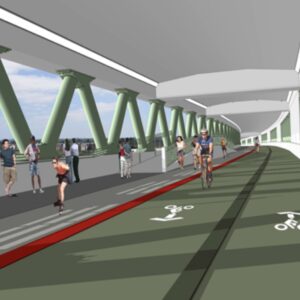
(Photo © J. Maus)
During his campaign, Obama got us all excited when he mentioned how Portland’s bike lanes should be an example for the rest of the country.
Now that he’s in office, I’m sure I join a lot of other people involved with biking who are eager for any sign that he’ll continue to publicly support bikeways.
Tipped off by a friend on Twitter, I browsed over to WhiteHouse.gov the other day. Turns out, as Obama was taking the Oath of Office, his web team was hitting the upload button on the newly updated website.
Excited to see if there was any mention of bicycling, I entered it into the search bar. I found one result.
On the Urban Policy page, under a heading of “Livability of Cities” is the following paragraph:
Build More Livable and Sustainable Communities: Our communities will better serve all of their residents if we are able to leave our cars to walk, bicycle and access other transportation alternatives. President Obama will re-evaluate the transportation funding process to ensure that smart growth considerations are taken into account.
It might be only one mention, but it’s well-said and it’s something to hang our helmets on. It also shows that someone on his staff thinks of biking as more than just a recreational pursuit (something critics have worried about in recent months).
Now it’s up to us and members of Congress to turn that paragraph into practice.





I like what I hear!
So, people…
Ask not what your Country can do for you, but what you can do for your Country!
That little blurb hits on a topic I’ve been thinking a lot about lately – and that is that automobiles have enabled sprawl. Neighborhoods used to be their own communities, they each had their own store, their own theater, their own restaurants, and because people got around by walking or biking, everything needed for daily life was within 5 miles or so (or not much further). As automobiles gained popularity (and because in the US we had lots of room to sprawl), this all changed, and now especially people in the suburbs sometimes have to travel more than 5 miles to get groceries. I like the idea of trying to curtail the sprawl a bit, and to go back to having more or less self-sufficient communities where a bicycle would be ideal transportation for most daily needs.
I know that won’t be possible everywhere, but I think even in some of the suburban areas, this could be retrofitted to some extent, so that a neighborhood community could have a store, a theater, etc and people would be more willing to use transportation that required physical exertion (but not too much physical exertion).
Living in SE Portland, we have everything we need within 5 miles easy (including work and entertainment), and it makes it easy to get to any of that on a bike. It would be great to see some urban planning that tried to structure more communities like that – they could include community gardens and recreation centers even, and I think this would both easy peoples’ budgets, as well as making communities more sustainable and livable.
One more thing to note – although it is only one mention, it suggests we stop using our cars so much, which I think is maybe the most important issue when it comes to any real transportation change in America.
Here’s hoping he can and will back it up with some real action.
It would be nice if they broaden the value beyond livable cities and include the positive energy, security and greenhouse gas implications as well.
I like Dave’s retrofitted to bicycle idea.
I know Obama will do a lot more than what has been done so far. He like’s bikes! http://brooklynbybike.wordpress.com/2009/01/21/bike-love-obama-and-the-inauguration/
But in all seriousness, let’s not forget it is up to us to hold our administration accountable…they are supposed to represent us after all.
Chris Smith over at Portlandtransport.org talked about the “20 Minute Neighborhood” during the recent snow.
http://portlandtransport.com/archives/2008/12/a_shout_out_fro.html
http://portlandtransport.com/archives/2008/12/the_resilience.html
Dave, the concept you mention is just what Metro and other planning agencies have been working toward… the town center concept. As a Portland transportation planner told me several years ago, the goal used to be to design a system that would allow anyone in the metro region to drive to any other area in a half-hour.
Then by the 1990s they realized the folly of that goal and began encouraging town centers, so that people could get most of what they want within a few miles, so they simply wouldn’t need to crisscross the region.
Now, the identified town centers get priority for transportation and other investment. There’s more info, including maps of the town centers at:
http://www.oregonmetro.gov/index.cfm/go/by.web/id=6555
This is just the sort of planning that makes it increasingly possible to live, work, study, shop without always having to use a car.
Oh yeah, that was another thing that got me thinking about this whole topic – if during a snow storm, we were to focus on clearing pedestrian and bike facilities (and public transit along main routes), it would increase EVERYONE’S mobility, not just those who have 4 wheel drive pickups. Not to mention, if you lived within a few miles of everything you needed, there would be no need to feel stranded in your house, stock up like the end of the world is coming, etc.
This phrase on the same “Urban Policy” page is noteworthy:
“nearly one-third of Americans live in neighborhoods without sidewalks and less than half of our country’s children have a playground within walking distance of their homes. President Obama introduced the Healthy Places Act to help local governments assess the health impact of new policies and projects, like highways or shopping centers.”
Looking at roads, paths, and trails as more than just a way to move about, but as integral to community and personal health, will shift transportation decision… and inevitably boost the role of bicycles and feet.
The White House website statement is great, however it’s not new. It was previously part of Obama’s 2008 election campaign website, with identical wording.
Thankfully it was not deleted when content was transferred over to the White House site.
i got a bunch more results.
Legislatively it might be up to Congress, but we have to continue to remind our congressmen and congresswomen about the importance of bicycling as transportation. The squeaky wheel gets the grease.
Time to start doing instead of just assessing.
It’s all great that the government wants to assess liveable communities, etc. It’s time to walk the walk, or ride the ride as the case may be!
Talk is cheap.
Hi Dave (#2 et al):
The idea you’re talking about is the foundation of “New Urbanism” (http://en.wikipedia.org/wiki/New_Urbanism) and has gained momentum since the 80’s as an answer to strip malls invading the countryside. There are tomes written on the subject of sprawl and its containment, ranging from automobiles to economics to zero-growth perspectives, but you’ve stated the fundamentals concisely.
Unfortunately when it comes to biking as viable transportation, public perception and attitude comes into play as much as planning. Generations of youth became accustomed to post-war growth and idolized cars as symbols of independence, and some even perceive alternatives as a threat to a patriotic ideology. We’ve simply become used to getting in our cars to get groceries, even when the store is in walking distance, because it’s status quo.
I hope this country’s leadership can communicate in a manner that mitigates this attitude and promotes general acceptance of change and alternatives (carpooling, walking, bike commuting, etc). Our last leadership spawned an era of accelerated consumerism with messages of “go out and spend money to get the economy rolling” during the last recession (~2001), so I tend to believe what the President says lends credibility to the direction of thought of the American people, regardless of who the President is. Of course the government’s action (tax rebates, lowered interest rates, etc) plays just as strong a role, so the saying “put your money where your mouth is” comes to mind.
…or should I say “put our money where your mouth is.” 😉
Pete: ironically, “new urbanism” is of course based on “old urbanism” of which most of N/NE/SE Portland west of 82nd is a part of.
The question is how to rebuild our neighborhoods so they are more pedestrian friendly? How do you support all those stores and businesses with enough residents and customers without needing to have people drive down from Vancouver?
For those of you who aren’t in the know, thats why we have the Pearl District: it was, so far, the most successfully redeveloped neighborhood in the city by adding density and public amenities. It was also developed mostly by a community organization, along with the city and developers.
Oh well, just food for thought.